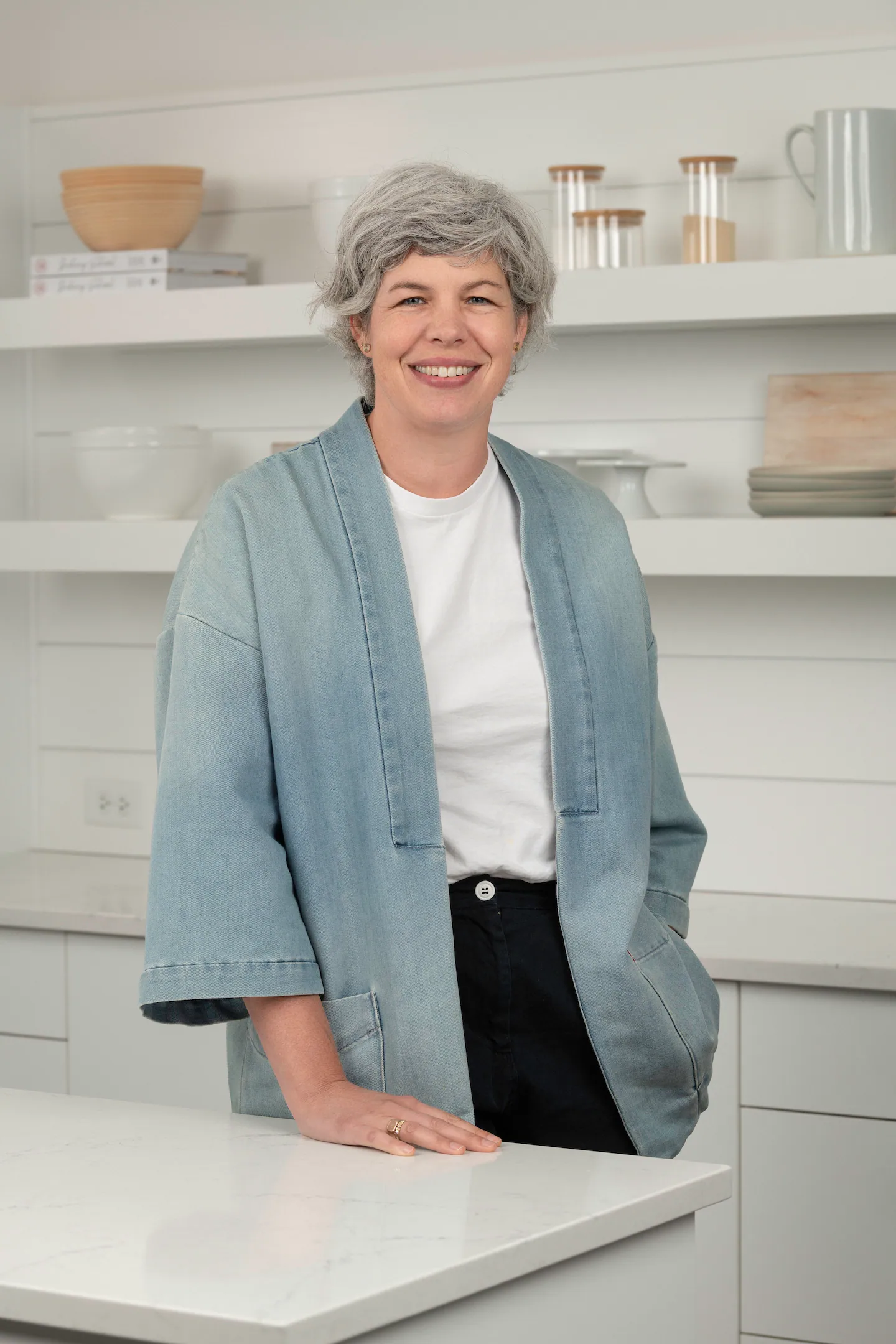
Before King Arthur, she was a longtime food writer, cookbook author, and collaborator, including on former Boston chef Matthew Jennings’s “Homegrown: Cooking from My New England Roots.”
Her latest cookbook with King Arthur is designed for junior chefs. “Sweet & Salty,” out on Tuesday, Sept. 30, blends sweet and savory recipes and easy-to-follow tips. She talks about her favorite recipes, her cooking-with-kids tips, and her top spots to eat in her current hometown of Portland, Maine.
How did this cookbook come to be?
You know, we do a lot with kids in the immediate community. We have a program called Bake for Good, where representatives go into elementary schools and do baking demos. We also send baking kits to teachers across the country, so they can bake with their students, and we provide all the ingredients and the support. There’s always been this undercurrent of interest in getting kids baking earlier, and we didn’t have a kids’ book.
I have two kids who are a little bit older now. They’re 14 and 12. I sort of looked at the other kids’ cookbooks on the market. There are some standouts, but there are also a lot of cookbooks that, I think, are more “some assembly required”: more decorating-focused.
Education is a huge piece of what we do at King Arthur. I wanted to do this book for kids that has an educational aspect to it, where kids can actually learn real skills that they’ll be able to carry with them and build on forever.
Before I came to King Arthur, when I was living in Northern California, for a period of three years when my kids were in preschool, I worked at their school as the lunch lady. It was such a great gig. I got to see my kids often throughout the day, but I also had carte blanche to make lunch for 200 K through 8 students every day.
What I noticed is that kids are naturally curious about food. They’re naturally interested in cooking and baking. I think we don’t always give kids as much credit as we should. They’re actually pretty capable if you set them up for success. With good, solid instruction, they’re capable of great things. The undercurrent of the book is: I’m not going to talk down to these kids, because I think they can tell when you do that.
How did you get the position at King Arthur? It sounds like a dream job.
It is really cool. I started at King Arthur a little over three years ago, and I came from a background of food media. The last probably 15 years of my career were really devoted to recipe development and cookbook collaboration. I came to King Arthur in part because they wanted to expand their offerings book-wise.
I grew up 15 minutes away from the King Arthur headquarters in Norwich, Vt. I had grown up with the brand, and I had admired a lot of the recent hires that they made. I sort of felt like, gosh, if I could work for a values-based company that I already love, and do the work that I have been doing, sign me up for that.
I think it’s a very special place to work. The company now has about 400 employees across all divisions, and it is an employee-owned company. It’s also a values-based company. I felt like my own personal values were sort of reflected with those of the company, which you don’t always see.
What does that mean?
I think employee ownership is one huge priority, which is amazing. Everyone feels like they have some skin in the game. We’re also a Certified B corporation, and we were one of the first Certified B Corporations. Now there are hundreds of them, which is great, but the idea behind a Certified B Corp is that it prioritizes people, the planet, and profit in equal measure.
The company has invested very much in the community in Vermont. We donate lots of money every year to food-based causes, which is very near and dear to my heart. There is this educational piece for kids. And so that feels good.
Was this always your dream career? Growing up in a slightly rural area, like I picture a very bucolic, bread-baking life.
I grew up in Vermont. My mom was a great cook, not much of a baker. I mean, she baked a little bit, but not a baker with a capital “B.” She made dinner for us every night, homemade birthday cakes. Everyone in my family loves food and loves cooking. It’s sort of the centerpiece of family events.
I went to Mount Holyoke, and I got history and English degrees, and I wasn’t sure at that point. I mean, who knows in college what you think you’re going to do? But I always loved food. Even at Mount Holyoke, my work study job was in the art museum. The curator knew I was interested in food. When they had artists come for openings, she asked me if I would want to cater these events. I would borrow kitchen space, take my car out, get groceries, and make food for these openings. I catered all through college, just to pay the bills.
Folks that I had catered with in college told me about this cooking school in Burgundy, France, where they had both worked. I spent six months working in France at this cooking school. I came back to Boston, and I got a job working at Formaggio Kitchen.
How was that?
Amazing. I worked there, off and on, for probably six years. I worked at the register. I worked at the bakery. I worked as a cheesemonger. I worked in the kitchen and cycled through all these jobs.
It’s hard now, because the world is so saturated with specialty food stuff. But at that time, in 2000, [owners Ihsan and Valerie Gurdal] were very ahead of their time. I was working there with other people who really cared about food. I got exposed to a huge breadth and depth of ingredients, makers, and artisans.
Who’s the audience for this cookbook?
Our intended audience is kids probably between the age range of 8 and 12. Obviously, it depends on your particular child, but I intended that kids could cook on their own, or with very little parental oversight. It’s lovely to cook with your kids. It’s also lovely to have an activity that you don’t have to do with your kids. I think younger kids can use this book with some assistance.
But I also just got a text this morning from a friend that I gave an advanced copy to. She has two kids, and she’s like: “Actually, I think maybe this book is for me!” Yes, this is marketed as a kid’s book, but I think it’s for anyone who likes easy-to-execute recipes that deliver a big bang for their buck. It’s a great foundational cookbook in that sense.
Any favorite recipes?
There’s a cherry cake in the book; a chocolate-covered cherry cake — a layer of chocolate cake with a layer of cherry frosting and then chocolate ganache over the top. That one is really fun and delicious.
There are some killer tortillas that are 50 percent wheat flour and 50 percent corn flour, so they roll beautifully. They’re great for quesadillas and things like that. It’s not very hard to make them from scratch, and they’re so much more delicious than most store-bought tortillas. For my kids, if anything is on a tortilla, they’re likely to eat it.
[I want kids to understand] intrinsically, the joy that baking brings. I think that is the inspiration for kids to continue, because they see just like how happy it makes the people around them and what a lovely gesture it is to bring something that you’ve baked to somebody, or just share something you’ve baked with somebody. I think kids get that.
I don’t care if my kids ever learn [cooking] fractions, but if they understand that there’s something joyful and generous in sharing food that you’ve made yourself, I think that’s going to serve them far better than knowing that a quarter-cup plus a quarter-cup makes half a cup.
What’s one piece of equipment that you can’t live without?
We sort of designed this book so that you don’t need a ton of tools. In the front of the book, there’s a very brief tool section. There’s a very brief safety section. And, in part, those were brief because I watched my kids interact with other children’s cookbooks, and they were like, “This is boring, boring, boring.”
One of the mistakes that parents make is that they buy their kids tools that are actually toys. They’re not real tools. They’re just things that resemble adult tools, but actually, functionally, don’t really work that well. I always feel like it’s good to give your kids scaled-down versions of tools that work really well. Give them a scaled-down, real wooden rolling pin rather than giving these toy things, which, frankly, I think, are very annoying to use. And I think kids find them very annoying to use, and I don’t think it sets them up for success. I think it’s just good to invest in some quality things that are scaled for the hands of the bakers in your life.
Where do you love to eat in Portland?
I love both Fore Street and Scales. They’re great spots, enduringly good. Leeward is newish. I think it’s probably three years old. They make their own pasta, and that’s really fun and delicious when it’s not prime tourist season. I’ll go and sit at the bar at Honey Paw, and they make smoked lamb khao soi. That’s really delicious. They always have fun and exciting specials, so I’ll go there when I can get in.
I like Ramona’s for their sandwiches. They make great breakfast sandwiches and lunchtime hoagies in that Philadelphia tradition, and I usually get the roasted pork and broccoli rabe one that’s really good. And there are so many good bakeries.
What’s your favorite bakery?
That’s hard. Everyone, me included, loves Tandem. I love Night Moves, which is across the bridge of South Portland. They make beautiful bread using freshly milled, Maine-grown flour and other treats. Oh, Bread & Friends. Those are old friends of mine from San Francisco that opened a very sweet spot, I think, two years ago, and they make pastries as well as bread. They serve brunch, too. That’s a fun spot.
What would you eat for your last meal on Earth?
I would probably eat some variation of beans and greens — cooked beans, and some sort of sauteed greens, or braised greens. Any white bean is good. And I don’t know, a chunk of buttered bread with good, salty butter, maybe a plate of French fries — and chocolate mousse for dessert.
Interview was edited and condensed.



